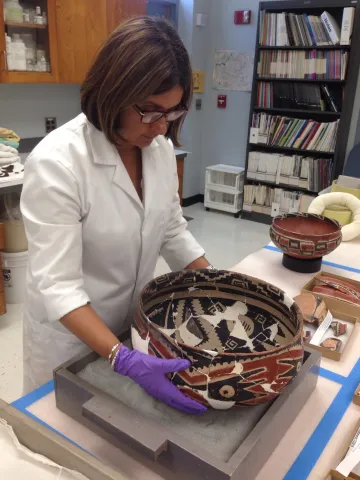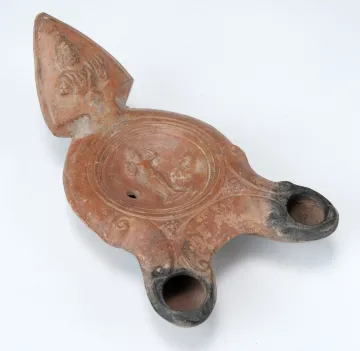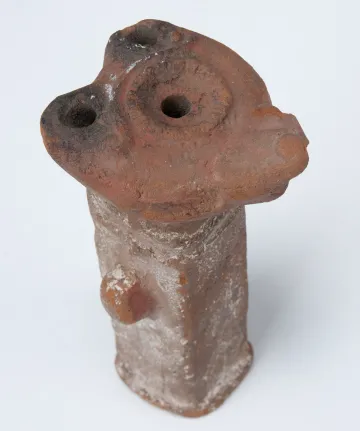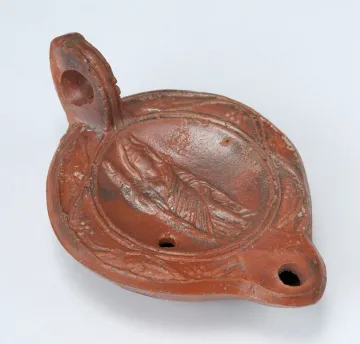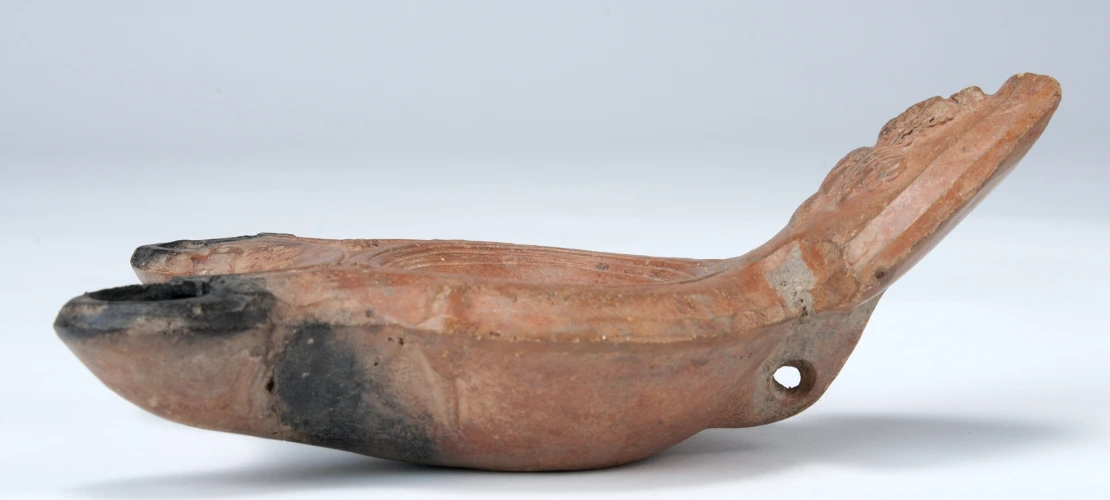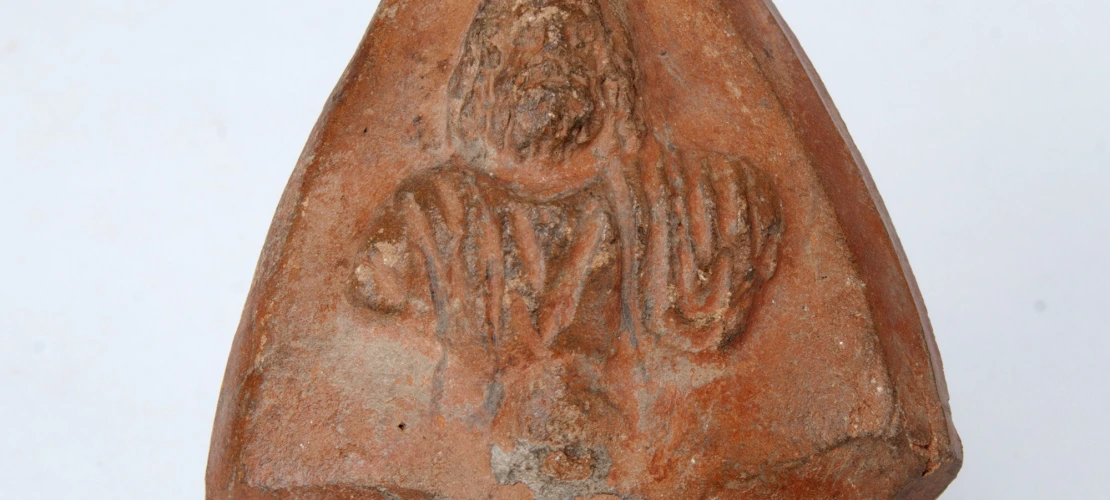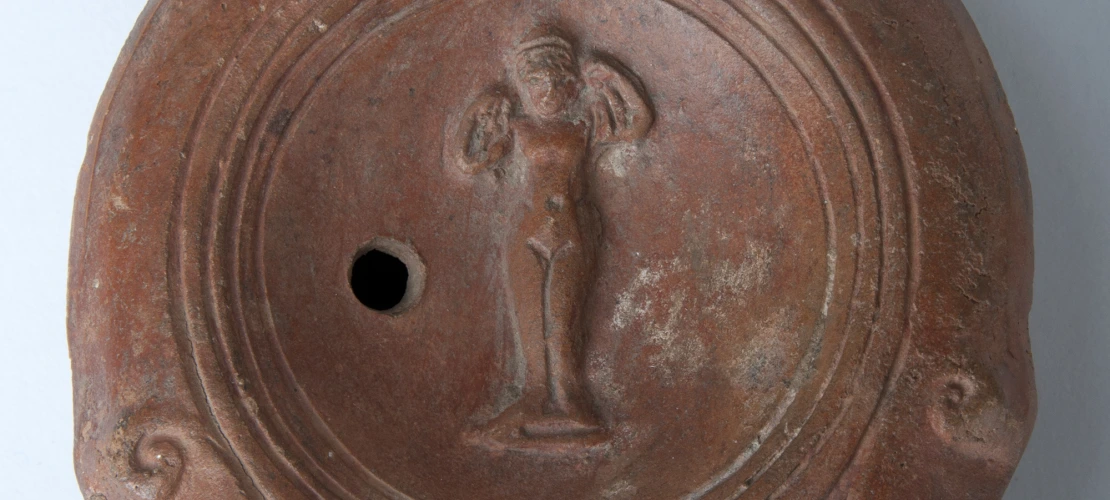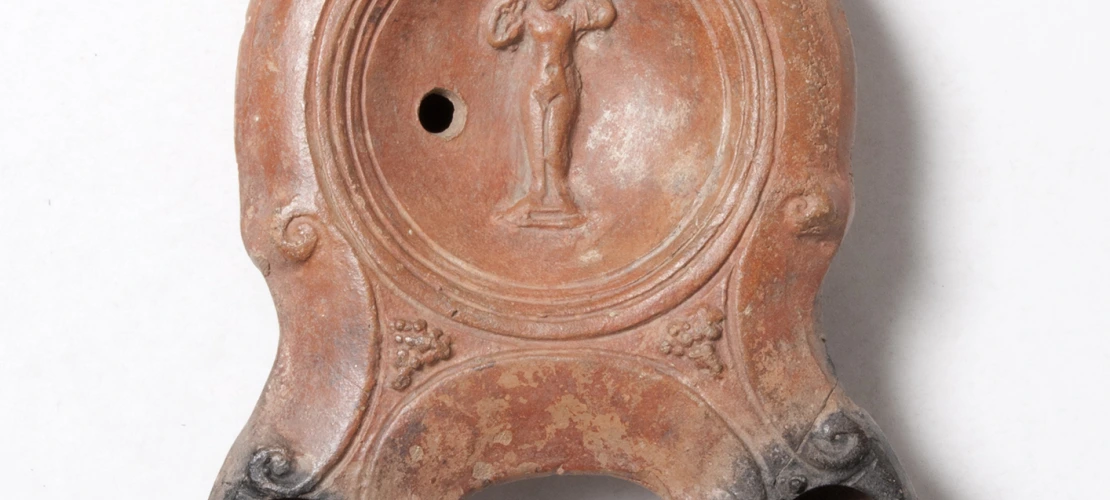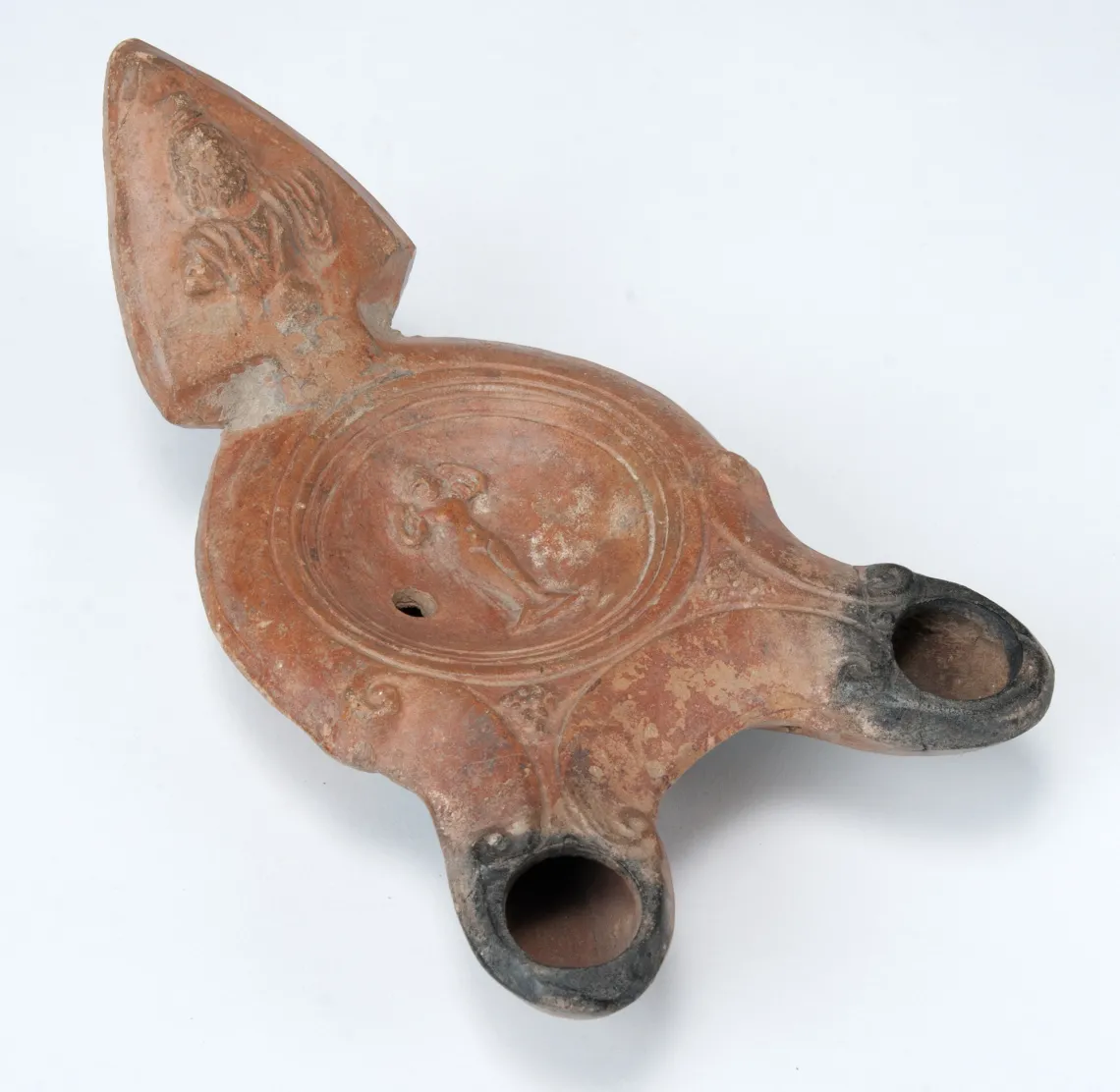
13237
Roman Imperial Lamp
Late first to second century CE
Egypt, Roman period
Mold-made ceramic oil lamp
Length: 6.4 in. (16.2 cm.), Width: 3.7 in. (9.5 cm.)
Height of bowl: 1.3 in. (3.3 cm.)
Height of handle guard: 2.7 in. (6.9 cm.)
Collected in Cairo, Egypt
Gift of Lily S. Place, 1924
(ASM Catalog No. 13237)
Each lamp has a filling hole where the fuel was poured in. Usually, this was olive oil, but sesame, nut, castor, and other plant oils, as well as fish oil and mineral oil were also used. Also present are one or more wick holes, where wicks made from linen, papyrus, oakum (fiber coated with tar), or asbestos (which does burn, but very slowly) were placed and lit. Oil lamps were a necessity in everyday life and were used by every stratum of the population.
This collection, its documentation, and its conservation were the subject of my MA thesis, completed in 1999. While working on my master’s degree in classical archaeology in the UA Department of Classics, I became interested in the field of art conservation, specifically the conservation of archaeological objects. I began interning in the ASM conservation lab. ASM conservator Dr. Nancy Odegaard, Archaeological Collections Curator Mr. Mike Jacobs, and I identified the collection of ancient lamps as a group of objects, collected during the early years of the museum’s history, that were in need of further documentation and conservation.
I produced a catalog of the lamps in the ASM collection and conducted the conservation condition assessment, analysis, and treatment as necessary. A number of the lamps had problems with soluble and insoluble salts, which were causing mechanical damage to the ceramic fabric. I enjoyed working with the lamps because I was able to combine my interests in classics and classical archaeology with materials analysis and conservation. After completing my MA I went on to get a second MA in the Conservation of Historic and Archaeological Objects from the University of Durham in the UK. I returned to ASM in my current position of faculty conservator in 2002.
Aristophanes was an ancient Greek poet of Old Attic Comedy, who lived from about. 457 to 385 BCE. Ecclesiazusae, or The Assembly of Women, is a social and political satire that dates to about 391 BCE. In the lines above, the protagonist, a woman named Praxagora, addresses the lamp, an inanimate object, in a parody of the pompous addresses made by male politicians of the time.
The Time and Place
During the Hellenistic period, which refers to the time between the death of Alexander the Great in 323 BCE and end of the Roman Republic and rise of the Roman Empire in the late first century BCE, Greek, or Hellenic, culture flourished throughout the eastern Mediterranean, which included Asia Minor, the Levant and Egypt. See a map of the Hellenistic world in 218 BCE here.
The Roman Empire (ca. 27 BCE to 5th–6th centuries CE), which reached its greatest expanse under the emperor Trajan (98–117 CE), extending from Britain in the west to Mesopotamia in the east, engulfed the Hellenized world and embraced its culture. See a map of the Roman Empire here.
Another Lamp of Interest
A second Roman Imperial lamp from this collection (ASM 13255, below) is of particular interest. Depicting the Greco-Egyptian goddess Isis-Demeter, it is signed in Greek on the bottom with the maker’s name ΠΑΡΑΜΟ|ΝΟΥ (Paramonos). In the absence of specific information regarding the lamp’s archaeological provenience, this signature, in addition to the lamp’s stylistic elements and decorative motif, offers valuable information regarding its date. Based on other similar lamps with the same signature and of known provenience and date, we know that Paramonos was an Egyptian lamp maker who worked in the period 150–250 CE.
The Donor
The donor of more than half of the lamps in the ASM collection, Lily S. Place, was an expatriate American who divided her time between Cairo, Paris, and London during the 1920s. Besides ASM, she donated artifacts to the Metropolitan Museum of Art in New York, and was made an honorary member there. She also donated items to the Minneapolis Institute of Art. ASM staff have not been able to learn much more about her, except that her Cairo address was in the same neighborhood as the American University in Cairo, which is located in the area west of Tahrir Square (ASM Donor File). She died in London on April 28, 1929 (Anonymous 1929; Harris 2007: 116).
Antiquities and Egyptian Law
The purchase of antiquities was legal in Egypt as late as the early 1920s. In fact, "prior to the tightening of Egyptian laws in 1928 in the wake of the discovery of Tutankhamun's tomb, the Egyptian Museum in Cairo freely sold genuine antiquities that were regarded as superfluous" (Harris 2007: 111).
Today, Egyptian cultural patrimony is protected by the Supreme Council of Antiquities (SCA). The SCA's website outlines the development of national antiquities law:
It was not until the 1850s, with the creation of an Egyptian antiquities service, that the hemorrhage of artifacts, from the smallest amulet to the most colossal of statues, began to slow. Since then, Egyptian antiquities laws, which have become more stringent over time, have been in place to control the unchecked flow of objects out of the country. The following are the essential elements of these laws:
Any artifact which has been duly recorded as Egypt's national property, regardless of the date of its discovery, must be regarded as such for perpetuity unless a clear record exists of its legal sale or transfer to another owner.
The permission of the Egyptian government has been required for all archaeological excavations since 1869. Illegally excavated antiquities are also to be considered Egypt's national property.
All monuments and artifacts uncovered in the country since 1983, whether or not they have been registered and under whatever circumstances they were excavated, are the undisputed property of the Egyptian government.
Hover your mouse over the image to halt the slideshow
Roman Imperial Lamp
Late first to second century CE
Egypt, Ptolemaic period
Mold-made ceramic oil lamp
Length: 6.4 in. (16.2 cm.), Width: 3.7 in. (9.5 cm.)
Height of bowl: 1.3 in. (3.3 cm.)
Height of handle guard: 2.7 in. (6.9 cm.)
Collected in Cairo, Egypt
Gift of Lily S. Place, 1924
(ASM Catalog No. 13237)
Links
Map of the Hellenistic world in 218 BCE from Wikimedia Commons.
Map of the Roman Empire in 117 CE from Wikimedia Commons.
Lamps - Ancient Roman pottery - Wikipedia
The Internet Classics Archive | The Ecclesiazusae by Aristophanes
Early Roman Imperial Oil Lamps - Ancient Pottery Database
Supreme Council of Antiquities [Egypt] - Recovering Stolen Treasures
References
Anonymous
- 1929 Miss Lily S. Place. Bulletin of the Minneapolis Institute of Arts 18(20):1.
ASM Donor File
- 1924 Miss Lily S. Place Egyptian Collection: Catalog Numbers 12482 through 12501, 13181 to 13342, 21277-21283. Arizona State Museum, University of Arizona, Tucson.
Bailey, D.M.
- 1988A Catalogue of the Lamps in the British Museum, Vol.III:Roman Provincial Lamps. British Museum Publications, London.
Harris, W. Benson, Jr.
- 2007 The Drexel Collection: From Egypt to the Diaspora. In Servant of Mut: Studies in Honor of Richard A. Fazzini, edited by Sue H. D'Auria, pp. 111-119. Koninklijke Brill NV, Leiden.
Humphrey, John W., John P. Oleson, and Andrew Sherwood
- 1998 Greek and Roman Technology: A Sourcebook. Routledge, London.
Moreno, Teresa K.
- 1999 Catalog of Ceramic Lamps in the Arizona State Museum. Unpublished master's thesis, Department of Classics, University of Arizona, Tucson.






